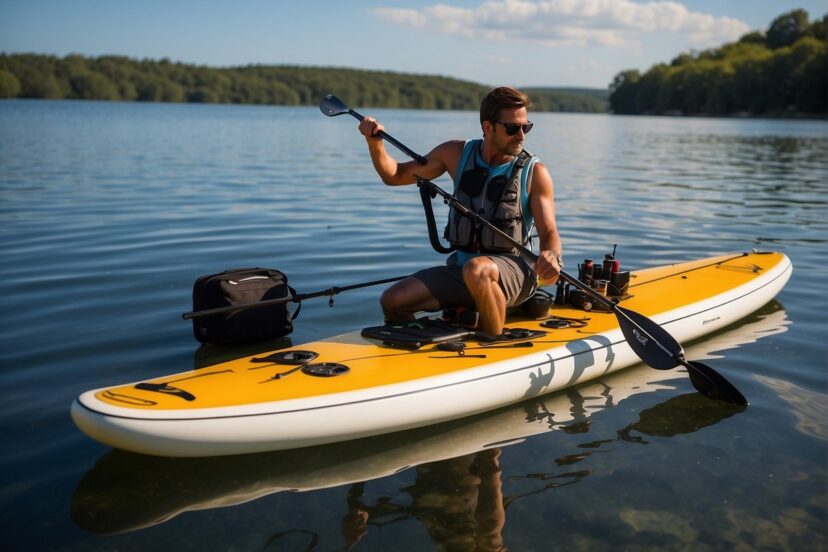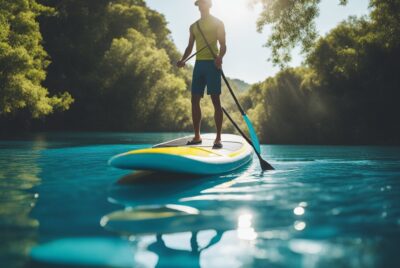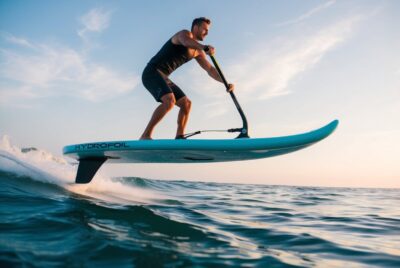Fishing Paddle Board Essentials: Gear Up for Your Next Adventure
*We may earn a commission for purchases made using our links. Please see our disclosure to learn more.
Fishing Paddle Board Essentials: Gear Up for Your Next Adventure
As an angler, I’ve noticed the increasing popularity of a fishing paddle board among enthusiasts looking to blend the excitement of stand-up paddleboarding (SUP) with the tranquility of fishing. These specialized paddle boards are designed to provide a stable platform for casting lines and reeling in fish from waters that might be inaccessible by boat. With enhanced features like rod holders, gear mounts, and increased stability, SUP fishing offers a unique experience that gets you up close and personal with your aquatic environment.

My experience with these boards shows that the key to a successful outing is choosing the right fishing paddle board to suit individual needs and preferences. Durability, stability, and weight capacity are crucial aspects to consider, as they directly impact the board’s performance in various water conditions. Whether it’s calm lakes or more challenging coastal waters, the right fishing SUP can offer a stealthy approach, allowing anglers to navigate silently and minimize disturbances to fish.
With a variety of options available, including both hard boards and inflatables, there’s a fishing paddle board for everyone. Inflatable SUPs tend to offer convenient transport and storage, while hard boards might provide better performance and speed. Customization is also a significant benefit, as many models come with add-on capabilities to tailor the board for specific fishing needs. My exploration into the world of SUP fishing has shown that it’s not just a fad; it’s a rewarding way to engage with the sport of fishing and enjoy the water from a different perspective.
Choosing the Right Fishing Paddle Board

When I’m selecting a fishing paddle board, my main considerations are the materials and durability, weight capacity, stability on the water, and whether to go with an inflatable or hard board. Each of these factors directly influences the fishing experience.
Materials and Durability
For any serious angler, a dual-layer PVC construction is the minimum I’d consider for an inflatable fishing paddle board. This material offers enhanced durability and resistance against punctures. A hard board, on the other hand, should have solid construction, potentially with a foam core and a fiberglass or carbon fiber overlay, which contributes to both durability and board performance.
Size and Weight Capacity
The dimensions of the paddle board—specifically the length and width—affect not just maneuverability, but also how much load the board can carry. I look for a board that is at least 10 feet long and 30 inches wide, ideal for stability and capacity. The weight capacity needs to match not just my weight but also the weight of my gear, which can be up to an additional 50-100 pounds.
Stability and Balance
Stability is paramount when fishing to ensure I can cast and reel in efficiently. Wider boards, typically over 32 inches, provide a solid platform for stability. Additionally, boards designed with fishing in mind often come with a lowered deck that helps with balance.
Inflatable vs. Hard Boards
Choosing between an inflatable SUP and a hard board can be challenging. Inflatable paddle boards offer ease of transport and storage and tend to be more forgiving when bumping against rocks or docks. Hard boards excel with better performance in terms of glide and speed on the water. I consider an inflatable board if I’m prioritizing convenience, and a hard board for optimized on-water performance.
Essential Fishing Paddle Board Features

When I’m selecting a fishing SUP, there are critical components I focus on to ensure a successful and enjoyable angling experience. These include robust options for securing gear, ample storage, and versatile attachment points.
Rod Holders and Gear Mounts
I can’t overstate the importance of having rod holders and gear mounts on a fishing paddle board. These features allow me to securely place my rods and fishing gear while paddling, casting, or even when I catch a fish. Some SUPs come equipped with built-in gear tracks which are fantastic for customizing the board for different fishing scenarios.
- Rod Holders: Essential for hands-free fishing and managing multiple lines.
- Gear Tracks: Convenient for attaching additional accessories such as fish finders or camera mounts.
Storage Options
Ample storage space is critical for a fishing SUP. I always look for options that allow for securing a tackle box and other essentials. Many boards feature a large deck space with bungee cords or dedicated storage areas for safely stowing gear and catches during the trip. A secure storage option might look like this:
- Tackle Box: Safe in a designated area, often near the standing zone.
- Bungee Cords: Flexibly secure my cooler or dry bag on the board.
Attachment Points and Bungee Cords
D-rings and bungee cords are invaluable for attaching gear and keeping it accessible. I make sure that a fishing SUP has multiple attachment points, which are great for tying down a cooler or strapping on extra equipment. These features should be strategically located around the board for optimal distribution of weight and ease of access.
- D-rings: Used to attach dry bags, coolers, and other gear with carabiners or ropes.
- Bungee Systems: Typically located at the front and rear of the board, they allow for quick and easy access to frequently-used items.
Fishing Paddle Board: Transportation and Storage
When considering a fishing paddleboard, I focus on how easily it can be transported and stored. These factors are crucial for my convenience and the longevity of the paddleboard.

Portability and Ease of Transport
When I’m on the move, portability is key. I prefer inflatable paddleboards for their ease of transport. Once deflated, they fit neatly into a backpack and can be carried anywhere. The collapsible dimensions of some models are space-efficient, like a typical board with dimensions around 41″ x 19″ x 13″.
Inflatables:
- Advantage: Can be deflated, rolled, and packed.
- Weight: Around 79 pounds with gear, manageable for one person.
Hard Boards:
- Transportation: Require a roof rack or a pickup truck bed.
- Handling: They can be heavy to carry over long distances.
Storage Solutions
For storage, keeping my paddleboard in a dry, cool place ensures it lasts longer. I use a dry bag to store personal items and a repair kit to handle any immediate maintenance issues. Here’s how I categorize my storage essentials:
- Inflatable Boards:
- After use: Wipe down, deflate, and roll up.
- Store in the backpack to protect from the elements.
- Hard Boards:
- Racks: I use wall-mounted racks in my garage.
- Covers: Protect from dust and sunlight exposure.
Each storage method considers preserving the integrity of the paddleboard and preparing for the next trip out on the water.
Performance and Maneuverability in Water

In assessing fishing paddle boards, I find that performance in the water and ease of maneuverability are pivotal. My paddling efficiency and the board’s behavior in various water conditions are fundamental to a successful experience.
Paddle Efficiency and Movement
When I paddle, the board’s response is crucial for maintaining speed and direction. I look for a paddle that is light enough for long duration use yet sturdy enough to propel me with minimal effort. The effectiveness of paddling is often determined by the paddle board’s shape and dimensions. For optimal performance, I prefer a board that is designed with a sleek shape, enhancing not only speed but also balance and stability. Side fins also play a part in this; they contribute significantly to the ease of directional changes while I troll and prevent unwanted sideward drift.
Navigating Different Water Conditions
My ability to handle different water conditions—from calm lakes to choppy coastal areas—relies heavily on the board’s design and features. Stability is paramount, and I generally opt for boards with wider beams which provide better balance. A flat aft section can be particularly advantageous as it resembles a boat’s stability. For maneuvering in shallow water, I ensure my fishing paddle board has enough lift to prevent grounding, and prefer removable fins that I can adjust according to the depth and bottom conditions. The board’s construction material also contributes to how it performs in water; military-grade materials usually offer a good balance of durability and maneuverability.
Accessories and Additional Equipment
When outfitting a fishing paddle board, I focus on functionality and safety. The right accessories can transform a simple SUP into a comfortable and efficient fishing rig.
Seating and Comfort
For those long days on the water, comfort is key. I usually opt for a light-weight cooler that can double as a seat, ensuring that it’s wide enough to guarantee stability on my board. If I’m looking for enhanced comfort, I’ll include a swivel seat, offering me the ability to turn and fish at different angles without compromising my balance.
Fishing and Trolling Motor
Essential to my fishing setup is the fishing rod holder—a simple, yet imperative item. Securing it with epoxy resin, rod holders keep my gear organized and ready for action. Adding a trolling motor to my SUP gives me the convenience of hands-free navigation and the ability to cover more water, which is quite useful on days with calm winds or when I’m feeling less inclined to paddle.
Safety Gear and Accessories
Safety takes precedence on the water, so I always carry a Stand Up Paddle Board PFD (Personal Flotation Device). I also make sure to have a reliable pump and paddles as part of my gear; the pump for inflating my SUP and the paddles as my primary means of propulsion. Safety gear also ensures compliance with local regulations, which often stipulate the necessity of having a life jacket on board.
Frequently Asked Questions
In my experience, anglers often have specific concerns when it comes to optimizing their gear for an efficient paddle board fishing experience. I’ll address some of the most common questions to clarify the essential details.
1. What are the key features to look for in a fishing paddle board?
When I select a fishing paddle board, stability and durability are my top priorities to ensure a safe and enjoyable outing. Boards with wide beams and higher weight capacities tend to offer a better platform for casting and reeling in fish. Storage options for tackle and catch as well as mounting points for rod holders and accessories are also crucial.
2. How can you set up a paddle board specifically for fishing purposes?
I usually start by attaching rod holders to keep my hands free. I also make sure there’s a reliable anchor system to maintain my position in the water. A cooler or storage compartment for my catch, along with additional mounts for equipment like fish finders, significantly improves the fishing setup.
3. What are the advantages of using an inflatable paddle board for fishing?
An inflatable paddle board offers me portability and easier storage. Its lightweight nature allows for effortless transport to remote locations. Additionally, modern inflatable boards are surprisingly rigid once inflated, providing ample stability needed for fishing.
4. What makes a paddle board suitable for saltwater fishing?
For saltwater fishing, I look for a paddle board with a robust construction capable of withstanding the corrosive effects of saltwater. Good traction on the deck pad to prevent slipping and a design that can handle choppy conditions are features I consider essential.
5. How does having a seat on a fishing paddle board enhance the experience?
Having a seat on my fishing paddle board allows for better comfort during long fishing sessions. It provides support and the option to alternate between sitting and standing, helping me to conserve energy for casting and reeling.




